湘教版五年级上册英语教案
- 格式:doc
- 大小:210.00 KB
- 文档页数:35

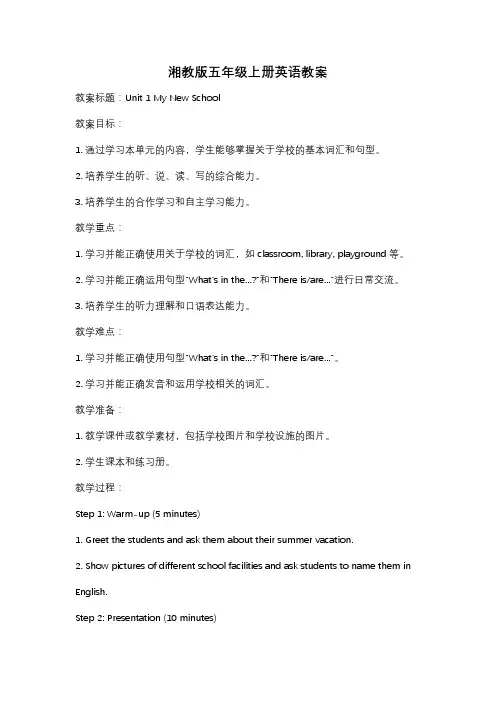
湘教版五年级上册英语教案教案标题:Unit 1 My New School教案目标:1. 通过学习本单元的内容,学生能够掌握关于学校的基本词汇和句型。
2. 培养学生的听、说、读、写的综合能力。
3. 培养学生的合作学习和自主学习能力。
教学重点:1. 学习并能正确使用关于学校的词汇,如classroom, library, playground等。
2. 学习并能正确运用句型"What's in the...?"和"There is/are..."进行日常交流。
3. 培养学生的听力理解和口语表达能力。
教学难点:1. 学习并能正确使用句型"What's in the...?"和"There is/are..."。
2. 学习并能正确发音和运用学校相关的词汇。
教学准备:1. 教学课件或教学素材,包括学校图片和学校设施的图片。
2. 学生课本和练习册。
教学过程:Step 1: Warm-up (5 minutes)1. Greet the students and ask them about their summer vacation.2. Show pictures of different school facilities and ask students to name them in English.Step 2: Presentation (10 minutes)1. Introduce the new vocabulary words: classroom, library, playground, etc. Use real objects or pictures to help students understand the meaning.2. Teach the sentence patterns "What's in the...?" and "There is/are...". Model the sentences and have students repeat after you.Step 3: Practice (15 minutes)1. Play a game of "What's in the bag?". Put different objects related to school ina bag and have students take turns guessing what's inside by asking "What's in the bag?".2. Divide the class into pairs. Give each pair a picture of a school facility and have them ask and answer questions using the sentence patterns learned.Step 4: Listening (10 minutes)1. Play an audio recording of a conversation about a school. Students listen and try to identify the school facilities mentioned.2. Have students do a listening exercise in their textbooks or workbooks, where they listen to a dialogue and circle the correct pictures representing the facilities mentioned.Step 5: Production (15 minutes)1. Have students work in pairs or small groups to create a poster or a brochure about their dream school. They should include pictures and descriptions of different school facilities using the sentence patterns learned.2. Students present their posters or brochures to the class, describing the facilities and explaining why they chose them.Step 6: Review and Wrap-up (5 minutes)1. Review the vocabulary words and sentence patterns learned in this lesson.2. Ask students to share one thing they learned or enjoyed about the lesson.教学延伸:1. Homework: Assign writing exercises or worksheets related to the vocabulary and sentence patterns learned in class.2. Extension activity: Have students visit a local school or research online to find more information about different school facilities. They can create a presentation or write a short report about what they learned.教学评估:1. Observe students' participation and engagement during class activities.2. Assess students' understanding through their responses during the practice activities.3. Review students' posters or brochures for accuracy and creativity in using the vocabulary and sentence patterns.。
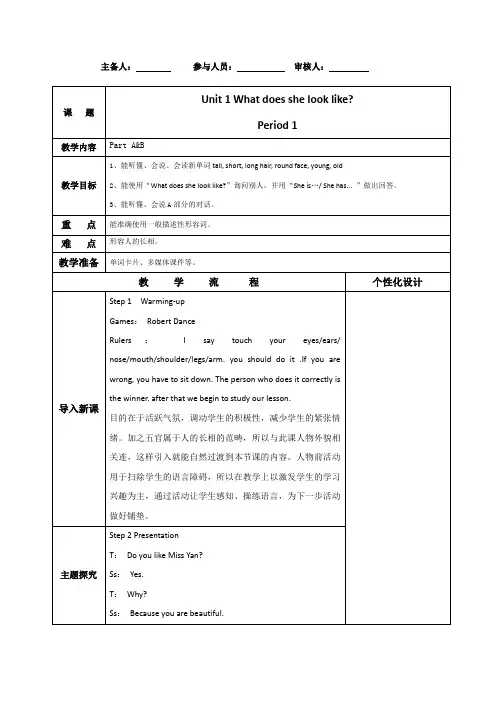
主备人:参与人员:审核人:主备人:参与人员: 审核人: 课 题Unit 1 What does she look like?Period 2教学内容 Part C&D 教学目标1.学完本课,学会描述人物外貌。
2.能积极思维,运用所学单词,短语及句型,结合实际生活进行灵活运用。
重 点 掌握本课新单词、句型和怎样描述一个人的外貌。
难 点 掌握运用动词have 和be 描述人物外貌的方法。
教学准备 单词卡片、多媒体课件等。
教 学 流 程个性化设计 导入新课 Step 1 Warming -upFree talk:让学生描述自己的家人、朋友及喜爱的明星,增添他人对自己的了解。
学生拿出事先准备好的自己最喜爱的电影、足球明星,在小组里轮流进行描述。
S1: I like Yao Ming very much. He is very tall. He has a big face...S2: Li Na is a good tennis player. She is beautiful. She has a round face...主题探究 Step 2 Let’s PracticeShow the pictures of teachers and then ask some students to talk about their teachers ’looks.S1: My Chinese teacher is…. S2: What does she look like?S1: She ’s not very tall. She has big eyes and a round face. S2: That ’s ….合作交流Step 3 Let’s read.Read the E -mails and then please fill in the chart.主备人:参与人员:审核人:课题Unit 2 I’d like a hamburger.Period 1教学内容Part A&B教学目标1、能听懂、会说、会读新单词hamberger, sandwich, Coke, fish, chicken,beef2、能运用“What does she look like?”询问别人,并用“She is…/ She has... ”做出回答。
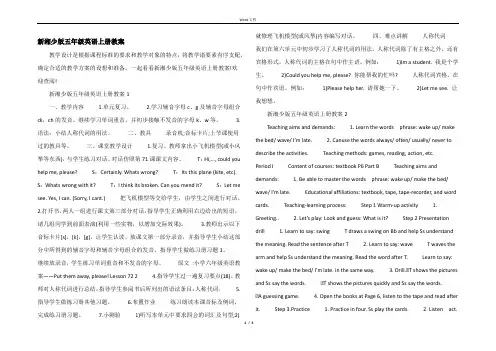
新湘少版五年级英语上册教案教学设计是根据课程标准的要求和教学对象的特点,将教学诸要素有序支配,确定合适的教学方案的设想和准备。
一起看看新湘少版五年级英语上册教案!欢迎查阅!新湘少版五年级英语上册教案1一、教学内容 1.单元复习。
2.学习辅音字母c、g及辅音字母组合ck,ch的发音。
继续学习单词重音,并初步接触不发音的字母k、w等。
3.语法:小结人称代词的用法。
二、教具录音机;音标卡片;上节课使用过的教具等。
三、课堂教学设计 1.复习。
教师拿出小飞机模型(或小风筝等东西),与学生练习对话。
对话仿照第71课课文内容。
T:Hi,…, could you help me, please? S:Certainly. Whats wrong? T:Its this plane (kite, etc). S:Whats wrong with it? T:I think its broken. Can you mend it? S:Let me see. Yes, I can. (Sorry, I cant.) 把飞机模型等交给学生,由学生之间进行对话。
2.打开书,两人一组进行课文第三部分对话。
指导学生正确利用右边给出的短语。
请几组同学到前面表演(利用一些实物,以增加交际效果)。
3.教师出示以下音标卡片[s],[k],[g],让学生认读。
放课文第一部分录音,并指导学生小结这部分中所得到的辅音字母和辅音字母组合的发音。
指导学生做练习册习题1。
继续放录音,学生练习单词重音和不发音的字母。
原文:小学六年级英语教案——Put them away, please! Lesson 72 2 4.指导学生过一遍复习要点(18)。
教师对人称代词进行总结,指导学生参阅书后所列出的语法条目:人称代词。
5.指导学生做练习册其他习题。
6.布置作业练习朗读本课音标及例词,完成练习册习题。
7.小测验1)听写本单元中要求四会的词汇及句型;2)就修理飞机模型(或风筝)内容编写对话。
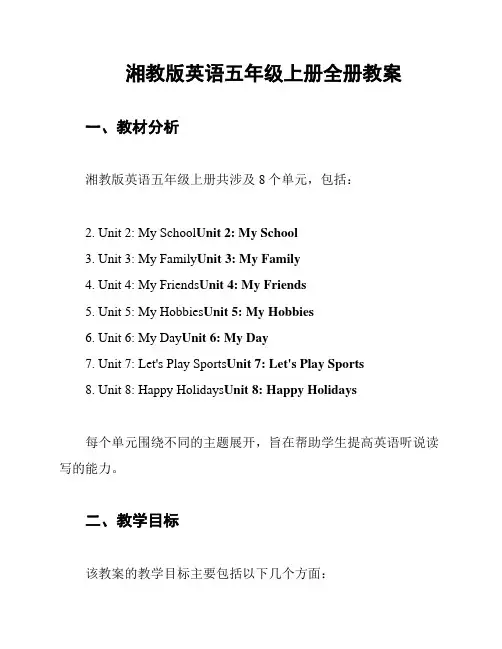
湘教版英语五年级上册全册教案一、教材分析湘教版英语五年级上册共涉及8个单元,包括:2. Unit 2: My School Unit 2: My School3. Unit 3: My Family Unit 3: My Family4. Unit 4: My Friends Unit 4: My Friends5. Unit 5: My Hobbies Unit 5: My Hobbies6. Unit 6: My Day Unit 6: My Day7. Unit 7: Let's Play Sports Unit 7: Let's Play Sports8. Unit 8: Happy Holidays Unit 8: Happy Holidays每个单元围绕不同的主题展开,旨在帮助学生提高英语听说读写的能力。
二、教学目标该教案的教学目标主要包括以下几个方面:1. 培养学生对英语的研究兴趣和积极性。
2. 通过听、说、读、写等多种教学活动,提高学生的综合语言运用能力。
3. 培养学生的合作意识和团队合作能力。
4. 培养学生的自学能力和信息获取能力。
三、教学内容和方法1. 教学内容:每个单元的教学内容包括词汇、语法、句型和对话等。
2. 教学方法:采用情境教学、任务型教学和合作研究等多种教学方法,灵活运用听、说、读、写的教学活动,提高学生的语言实际运用能力。
四、教学步骤1. 导入活动:通过唱歌、游戏等方式调动学生研究英语的兴趣,为后续教学做准备。
导入活动:通过唱歌、游戏等方式调动学生学习英语的兴趣,为后续教学做准备。
2. 词汇研究:通过单词卡片、图片等辅助工具,教授新词汇,帮助学生记忆和研究词汇。
词汇学习:通过单词卡片、图片等辅助工具,教授新词汇,帮助学生记忆和学习词汇。
3. 语法和句型练:通过示例句、练题等方式,引导学生掌握语法规则和常用句型。
语法和句型练习:通过示例句、练习题等方式,引导学生掌握语法规则和常用句型。
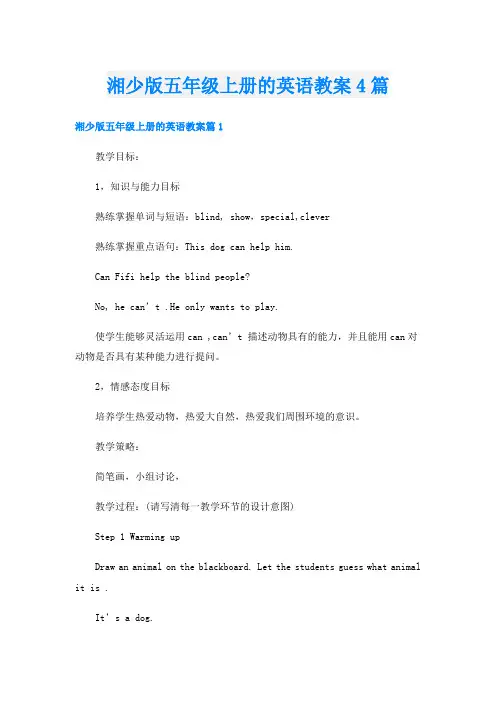
湘少版五年级上册的英语教案4篇湘少版五年级上册的英语教案篇1教学目标:1,知识与能力目标熟练掌握单词与短语:blind, show,special,clever熟练掌握重点语句:This dog can help him.Can Fifi help the blind people?No, he can’t .He only wants to play.使学生能够灵活运用can ,can’t 描述动物具有的能力,并且能用can对动物是否具有某种能力进行提问。
2,情感态度目标培养学生热爱动物,热爱大自然,热爱我们周围环境的意识。
教学策略:简笔画,小组讨论,教学过程:(请写清每一教学环节的设计意图)Step 1 Warming upDraw an animal on the blackboard. Let the students guess what animal it is .It’s a dog.(通过逐步画出的小狗既引起学生的兴趣,又引出本课关于导盲犬的话题) Step 2 Presentation and practice1. Draw a man beside a dog. Then draw the man to blind. Talk about it then teach the word“blind”.Watch a TV show and answer a question “Who can help the blind man ?”2. Listen to the passage and repeat it. Try to be the TV presenter.1)跟读一遍刚刚观看过的盲人与导盲犬的电视节目的*。
2)请学生试读缺少个别词语的*。
3)小组练习,根据每句提示词试复述*。
3.Listen to CDROM and answer the question “Can Fifi help the blind people? ”Write down the sentence on the blackboard and repeat it.4.Listen again and answer the question “What does he want to do?”5. Listen and circle the sentences with “can or can’t”.6. Memorizing game. Guess what the special animals can do .7. Listen the passage and repeat it.8. Do some exercises on AB p26 1: Read the text and circle.(通过听读和练习使学生对课文有基本的掌握,并能基本流利朗读、初步记忆)Step 4 Consolidation and extension1. Talk about pictures about some special animals. Then the students talk about them in group using "This…can … . This …can’t … . "3. Give each group a picture of an animal, let each group watch and discuss. For example, “It’s white. It’s fat. It can catch the mouse. It can’t swim.”Then show it.(通过练习使学生既掌握住can和can’t的用法并复习形容词的用法,又学会对动物能力的描述)Step 5 Summary1,引导学生自主回顾本节课所学知识,引导学生发现生活中动物对人类的帮助,培养学生热爱动物,热爱大自然的意识。
Unit 1 What does she look like?Ⅰ. Teaching aims and demands1. new words study(1) Learn some new words: tall, short, young, old(2) Learn some other new words: long hair, round face2. Learn some useful sentences:(1)What does she/he look like?(2)He/she is tall.(3)He/she has small eyes.Ⅱ. Teaching aids: Tape record /white paper/color pencilsⅢ.Teaching Process:Step 1 Review1. (One by one practise: Does she/he have …?2. T: Does she have long hair?S1: Yes, she does. Does he have short hair?S2: No, he doesn’t. He has long hair. Does she have a big nose?S3: Yes, she does. Does she have big ears?S4: No, she doesn’t. Does …?Step 2 RevisionLet’s the students review the words about the looking they have learnt. Step 3 Leading inAsk students a few questions.T: This boy, please. Do you have any brothers?S: Yes. I have one.T: What does he do?S: He is a worker.T: What does he look like?S: He has big eyes. He is fat.T: Ok. Then how to describe his build/height and haircut? etc. This class we will study Unit 1 What does she look like?(Show a slide : What does she look like?)Step 4:Pre-taskShow the topic words. (Show six pictures. There are some new words and expressions under them.)First explain the new words and expressions to the students. Then listen to the tape to learn them. Listen again.Step 5: Practise: ListeningShowa slide. Let the students listen to the tape and fill in the chart with the new words and expressions. Listen twice.Then ask them to talk about the answers each other and check the answers. At last tell the right answers to the students.Step 6: While-task. Explain and work in pairs.Show three pictures. Make a dialogue according to one of them. Explain it to the students. Then let the students make dialogues according to thepictures. Students work in pairs. They discuss carefully. Then let some students show their answers to other students. Then ask students which group is the best. The teacher praise them.Step 7: Practice: Pair work.Show four pictures about Luxun, Yaoming, Chenglong and Hanhong. Let the students work in pairs to describe the famous persons. Ask them to make some dialogues. The students are very careful. First they discuss in pairs. Then ask some students to show their answers to the other students. At last the teacher give the best answers. Tell the students they are very great. So we should learn to them.Step8: Post-task: Work in pairs.Show a picture. Make a dialogue according to the situation. Ask the students using the words and sentences we have learnt this class. Then they work in pairs. Ask some students to show us. Let the other students discuss which group is the best. They are the winners. It’s fun time.Step 9: SummarySum up what they have learnt.Step 10: Homework1. Copy the new words and Preview Section B.2. Collect some pictures about your favorite persons and describe them.3. Do a survey about the persons you like or don’t like. Tell us the reasons. Write a report in your exercise book.Unit 2 I’d like a hamburgerPeriod 1Teaching targets.1. The target of knowledge:1) Learn these new words: hamburger, Coke, food, sandwich, fish,chicken, beef2)Learn these sentences: What would you like?I’d like a hamburger, please./ I’d like some fish, please.2. The targets of skills:1) Can understand the skill words.2) Can understand the sentence structure.3. The targets of emotion: To form the health living habitMain points: The new words and sentences.Difficult point: Learn in order to practice.Teaching method and Learning way: Import methodTeaching aids: cards, tape, recordTeaching Process:Step 1 Warming up1. Greetings.2. Learn to sing a song—Do re mi3. Use the cards to go over the words Game—Guess ,guess, guess Step2 Presentation and drillT:Says the sentences and does the actions to helps pupils to understand the meanings. Learn the new words. Lead reading the words and check the results. According to the words, ask some questions and requires pupils to answer the questions. T: What would you like?…2. Game —Patting flies.3. Lead reading the words, and requires the pupils to act as a little teacher, lead reading.4. Look and say: High and low voiceStep3 Fast reading and listening1)Read the dialogue, then answer the question: What would you like? Teacher introduces the situation and requires the pupils to read the dialogue by themselves2)Listen and imitationStep4 Intensive doing1) Reading the dialogue carefully2) Listen and repeat the dialogue3) Retell the story ,check the resultPeriod 2Teaching targets.1) Consolidate these new words2) Can master these sentence structure: What would you like?3) Can retell the storyThe targets of emotion: To love the life.Main points: The new words and sentences.Difficult point: Can retell the text.Teaching aids: cards, tape, recordTeaching Process:Step 1 Warming up1. Greetings.2. Sing a song3. Use the cards to go over the wordsGame—Golden finger To tell partner which food you like best.Step2 Presentation and drillShow the new words: hamburger, sandwich, coke, fish, chicken, beef Enquire the pupils to read, go over the words. Teacher explain the grammar for the pupils .Ask students to read the dialogue of Part A, then the students are required to draw line under the adv.Step3 Practice Part D1) Practice in pairs, according to the form to say which food is your favourite.2) Group work3) Finish the hand writing, then check the answersStep4 Consolidation1) Make a situation and have a dialogue with their partners, choose some to act it out.2) Estimation3) Homework: Listen and read the dialogue, copy the new wordsPeriod 3Teaching targets:1)Go over these skill words, texts, grammars2) Can finish Part EMain points: The new words and sentencesDifficult point: Can describe the other’s favorite food.Teaching aids: cards, tape, recordTeaching Process:Step 1 Warming up1. Greetings. Go over the four-skill words2. Use the cards to go over the new dialogue, and make sentences with ―hamburger, sandwich, coke, fish, chicken, beefStep2 Presentation and drill1. Explain the sentences for the class, then require the pupils to communicate with others, according to the information in the form.2. Part E Write some food and draw it in the plate on the right to finish Part E, check the answers.3. Require the pupils to find the answers, say their answers first, then writedown on the book.Step3 Consolidation1) Make a situation and have a dialogue with their partners, choose some to act it out2) Homework: Listen and read the dialogue, copy the new wordsUnit 3 Do you want some rice?Teaching aims:1. Knowledge aimsLearning the new words and sentences just like lunch/ soup/ vegetable/ breakfast/dinner/tomato/potato/Do you want some rice? /Yes, please./No, thank you.2. Ability aimsImprove the students oral English and let students know something about like or dislike something, know some words of food.Let the students can make communication with each other.3. Moral aimsWe must attend the class seriously.Teaching methods:Reading. /Listening. /Talking. /Singing.Play Games.Making actions.Teaching aids:Computer/TV/a tape recorder / brushMain points and difficulties:New wordsExpressions and sentencesPart 1Step 1: Revision1. Greetings.Would you like to say “hello” to you friends?2. What food do you like?Step 2: Presentation1.Have a match between boys and girls, to see who can say out morefruits/drink/food words. Learn the new words and phrases: lunch/ soup/ vegetable/ breakfast/dinner/tomato/potatoT take an apple and ask: Do you want an apple? Help Ss answer the question in this way: Yes, please/ No, thank you.Ask Ss practice the dialogue with other things.Step 3: Drills1. Listen to the tape.2. Read after the tape.3. Read out the words and sentences according to the computer.Check up the result.Act the text.Step 4: Exercise1. Remember the words.2. Read Part A after class.Part 2Step 1: Revision1. Greetings.Good morning. /Afternoon everyone. / How are you? /Who is on duty today?2. Go over the words and sentences in part A and B.Step 2.Presetation1. Show some cards of food and fruits and ask Ss look and say out the words quickly.Make sentences according to the pictures giving. Can use the sentences learnt last class.Learn to say the sentence pattern:Do you want some soup?Yes, please.No, thank you.Step 3. Practice:1. Draw and make the cards.Play the cards game.Ask and find the cards, who can collect the whole cards of one thing, who can win the game.3. Read out the words and sentences according to the computer.4. Check up the result.Step 4. Exercise1. Remember the words.2. Read Part A after class.Part 3Step 1. Greetings and RevisionT: Class begins.S: Stand up. Good morning/afternoon teacher.T: Good morning/afternoon. Sit down please.S: Thank you!Revision.Words: lunch/ soup/ vegetable/ breakfast/dinner/tomato/potato2. Sentences: Do you want some rice?Yes, please.No, thank you.3. Understand the text of part D.4. Lead the students to finish the exercise in part E and F..Step 2: Presentation.1. Learn Part D: Ask Ss the text by themselves, find out the new words and sentences.Ask student to explain the meaning of the text.Finish the exercises.Step 3: Drills1. Read Part D after the teacher.2. Precise by themselves.3. Look at the pictures and finish part F. Step 4: Exercises1. Do the exercises book’s Part C and part D Try their best to recite A and B.Unit 4 Can I use your pencil, please? Teaching aims:1. Knowledge aimsLearning the new words and sentences just like use / English/ thing/ borrow/ Chinese/ dictionary/ eraser/ marker/ glue/ Can I use your pencil, please /Yes. Here you are.2. Ability aimsImprove the students oral English and let students know something about use / English/ thing/ borrow/ Chinese/ dictionary/ eraser/ marker/ glue and so on.Let the students can make communication with each other.3. Moral aimsWe must attend the class seriously.Teaching methods:Reading. /Listening. /Talking. /Singing.Play Games.Making actions.Teaching aids:Computer/TV/a tape recorder /comb/brushMain points and difficulties:New wordsExpressions and sentencesTeaching steps:Part 1Step 1: Revision1. Greetings.Good morning. /Afternoon everyone. / How are you? /Who is on duty today?Step 2: Presentation1. Turn on the computer and learn the words according to the pictures: use / English/ thing/ borrow/ Chinese/ dictionary/ eraser/ marker/ glue2. Learn the sentences according to the words and pictures: Can I use your pencil, please /Yes. Here you are.Step 3: Drills1. Listen to the tape.2. Read after the tape.3. Read out the words and sentences according to the computer.4. Check up the result.Step 4: Exercise1. Remember the words.2. Read Part A after class.Part 2Step 1: Revision1. Greetings.Good morning. /Afternoon everyone. / How are you? /Who is on duty today?Step 2.Presetation1. Turn on the computer and learn the words according to the pictures: use / English/ thing/ borrow/ Chinese/ dictionary/ eraser/ marker/ glue2. Learn the sentences according to the words and pictures: Can I use your pencil, please /Yes. Here you are.Step 3: Drills1. Listen to the tape.2. Read after the tape.3. Read out the words and sentences according to the computer.4. Check up the result.Step 4: Exercise1. Remember the words.2. Read Part A after class.Part 3Step 1: Greetings and RevisionT: Class begins.S: Stand up. Good morning/afternoon teacher.T: Good morning/afternoon. Sit down please.S: Thank you!Revision.1. Words: use / English/ thing/ borrow/ Chinese/ dictionary/ eraser/ marker/ glue2. Sentences: Can I use your pencil, please /Yes. Here you are.3. Lead the students to learn the new knowledge.Step 2:Presentation.1. Learn Part D: What are you making, Mingming?I’m making a kite. Oh, dear! I forget to bring my glue. Can I borrow your glue?2. Ask student to use the knowledge they have learnt to finish the exercises work.Step 3: Drills1. Read Part D after the teacher.2. Precise by themselves.3. Play some games.Step 4: Exercises1. Do the exercises book’s Part C and part D2. Try their best to recite A and B.Unit 5 Can I have a pet?Period 1Teaching targets.1. The target of knowledge:1) Learn these new words: pet rabbit basket lovely hold sure2) Learn these sentences: Can I have a pet? Yes, you can.2. The targets of skills:1) Can understand the four –skill words.2) Can understand the sentence structure.3.The targets of emotion: To know something about pet.Main points: The new words and sentences.Difficult point: Learn in order to practice.Teaching method and Learning way: Import methodTeaching aids: cards, tape ,recordTeaching Process:Step 1 Warming up1. Greetings2. Use the cards to go over the words Game—Guess ,guess, guess Step2 Presentation and drillT says the sentences and does the actions to helps pupils to understand th e meanings. Learn the new wordsLead reading the words and check the results.According to the words, ask some questions and require pupils to answer the questions.1. T: Can I have a pet?2. Game –Patting flies.3. Lead reading the words, and require the pupils to act as a little teacher, lead readingStep3 Fast reading and listening1)Read the dialogue quickly, then answer the following question :Can I have a pet?Teacher introduces the situation and require the pupils to read the dialogu e by themselves.Step4 Intensive doing1) Reading the dialogue carefully2) Listen and repeat the dialogue3) Retell the story ,check the resultPeriod 2Teaching targets:1) Consolidate these new words2) Can master these sentence structure: Can I have a pet?3) Can retell the storyThe targets of emotion: To love the animals.Main points: The new words and sentences.Difficult point: Can retell the text.Teaching aids: cards, tape ,recordTeaching Process:Step 1 Warming up1. Greetings.2. Use the cards to go over the words Game—Golden fingerTo tell partner which animal you are like best.Step2 Presentation and drillShow the new words: pet rabbit basket lovely hold sure Requires the p upils to read ,go over the words.Teacher explains the grammar for the pupils.Ask students to read the dialogue of Part A, then the students are required to draw line under the words they can’t understand.Eg. Can I have a pet? Step3 Practice1) Practice in pairs, according to the form to practice the dialogue.2) Finish the hand writing, then check the answersStep4 Consolidation1)Make a situation and have a dialogue with their partners, choose oneto act it out.2)Homework: Listen and read the dialogue, copy the new words Period 3Teaching targets:1)Go over these four-skill words, texts, grammars Can finish Part E Main points: The new words and sentencesDifficult point: Know how to have a pet.Teaching aids: cards, tape ,recordTeaching Process:Step 1 Warming up1. Greetings.2. Use the cards to go over the new dialogue, and make sentences with ―pet rabbit basket lovely hold sureStep2 Presentation and drill1.Explain the sentences for the class ,then requires the pupils tocommunicate with others ,according to the information in the form.2. Part E to finish Part E, check the answers.3. Requires the pupils to find the answers, say their answers first, then write down on the book.Step3 Consolidation1)Make a situation and have a dialogue with their partners, choose oneto act it out2)Homework: Listen and read the dialogue, copy the new words ,and tryto recite text .Unit 6 Which one do you want?Period 1Teaching targets.1. The target of knowledge:1) Learn these new words:which raincoat thick thin jacket umbrella clothes old2) Learn these sentences: Which one do you want? I want the ...2. The targets of skills:1) Can understand the four –skill words.2) Can understand the sentence structure.3.The targets of emotion: To describe the wears...Main points: The new words and sentences.Difficult point: Learn in order to practice.Teaching method and Learning way: Import methodTeaching aids: cards, tape, recordTeaching Process:Step 1 Warming up1. Greetings.2. Use the cards to go over the words Game—Guess ,guess, guess Step2 Presentation and drillT Says the sentences and does the actions to helps pupils to understand the meanings. Learn the new wordsLead reading the words and check the results.According to the words,ask some questions and requires pupils to answer the questions.T: Which one do you want?1.Lead reading the words, and require the pupils to act as a little teacher,lead readingStep3 Fast reading and listening1)Read the dialogue quickly, then answer the following question :Which one do you want?Teacher introduces the situation and requires the pupils to read the dialogue by themselves.Step4 Intensive doing1) Reading the dialogue carefully2) Retell the story, check the resultPeriod 2Teaching targets.1) Consolidate these new words2) Can master these sentence structure: Which one do you want?3) Can retell the storyThe targets of emotion: To love the animals.Main points: The new words and sentences.Difficult point: Can retell the text.Teaching aids: cards, tape, recordTeaching Process:Step 1 Warming up1. Greetings.2. sing a song 《The Doggie in the window》3. Use the cards to go over the words Game—Golden fingerTo describe the wears and so on.Step2 Presentation and drillShow the new words:which raincoat thick thin jacket umbrella clothes old Requires the pupils to read, go over the words. Teacher explains the grammar for the pupils .Ask students to read the dialogue of Part A, then the students are required to draw line under the words they can’t understand.Step3 Practice1) Practice in pairs, according to the form to practice the dialogue.2) Finish the hand writing, then check the answersStep4 Consolidation1)Make a situation and have a dialogue with their partners, choose oneto act it out.2)Homework: Listen and read the dialogue, copy the new wordsPeriod 3Teaching targets.1)Go over these four-skill words, texts, grammars2) Can finish Part EMain points: The new words and sentencesDifficult point: Know how to choose the things that you like better. Teaching aids: cards, tape, recordTeaching Process:Step 1 Warming up1. Greetings.2. Use the cards to go over the new dialogue, and make sentences with ―which raincoat thick thin jacket umbrella clothes oldStep2 Presentation and drill1.Explain the sentences for the class ,then requires the pupils tocommunicate with others ,according to the information in the form.2. Part E to finish Part E, check the answers.3. Require the pupils to find the answers, say their answers first, then write down on the book.Step3 Consolidation1) Make a situation and have a dialogue with their partners2) Homework: Listen and read the dialogue, copy the new words, andtry to recite text.Unit 7 What time do you get up?Period 1教学目标能听懂会说新单词get up, go to bed, timetable, computer, lesson, PE, art, maths能听懂会说本课对话能用句型“What time do you _____?”询问他人的作息情况,及对此询问做出回应教学重点及难点重点理解并正确运用课文A部分中对话就有关他人的作息情况进行回答。
2022湘少版五年级上册英语教案5篇2022在教学中我严格遵从教学的五个环节,课前认真备课,做到既备教材,又备学生,因材施教,努力实施课堂改革,积极探索小学英语快乐课堂,小学阶段英语教学的目的是:激发学生学习英语的兴趣,培养学生学习英语的积极性,使他们树立学习英语的自信心。
以下是小编带来的2021湘少版五年级上册英语教案内容,感谢您的阅读,希望能帮助到您!2021湘少版五年级上册英语教案1Module 2 Unit 1She learnt English.教学目标1.学会词汇learnt these dancer2.能听懂会说Unit 1这篇对话。
3.学习目标语句:Did your grandma learn English? Yes, she did. /No, she didn’t.4.能口头运用Did your grandma learn English?这类语句询问过去的行为,并能口头运用Yes, she did./No, she didn’t.回答。
教学重点:学会词汇learnt these dancer教学难点:运用目标语句She danced in lots of Chinese cities .Did she learn any foreign languages? Yes, she did. /No, she didn’t. He was a dancer .谈论过去。
教学过程:Step1.预习检测根据所给单词,补全句子。
1. Sam was____then.Now he is_____.(short tall)2. My mother___ ______then.Now she___ ___.(old young)Step2.合作探究,学习课文。
1. 听课文录音,理解课文大意。
2. 小组内学习课文。
3. 师解决疑惑。
4. 学生自己读课文,找出下面问题的答案。
Who are they ?Why is she wearing these clothes?Did she learn English?Step3.巩固练习完成课本第三部分。
【新教材】新版湘科版五年级上册英语全册教学设计教案一、教学目标- 帮助学生掌握五年级上册英语的基础知识和技能。
- 培养学生的听、说、读、写的能力。
- 培养学生对英语研究的兴趣和自信心。
二、教学重点- 学会正确发音和应用五年级上册英语的单词和短语。
- 理解并运用五年级上册英语的句型和语法知识。
- 通过听、说、读、写的综合训练,提高学生的英语综合应用能力。
三、教学内容本教学设计教案包括五年级上册英语全册的全部内容。
主要包括以下几个模块:1. Unit 1: Greetings and Introductions2. Unit 2: Numbers and Colors3. Unit 3: Daily Routines4. Unit 4: Family and Pets5. Unit 5: Food and Drink6. Unit 6: Time and Weather每个单元的内容包括听力训练、口语表达、阅读理解和写作练等。
四、教学方法1. 情境教学法:通过设置真实的情境,让学生在语言运用中获得真实的体验。
2. 合作研究法:通过小组合作研究和交流,培养学生的合作意识和团队精神。
3. 多媒体教学法:运用多媒体技术辅助教学,提高学生的研究兴趣和参与度。
五、教学评估1. 听力测试:通过听力理解题目的方式测试学生的听力水平。
2. 口语问答:通过口头问答来考察学生的口语表达能力。
3. 书面作业:布置相关的书面作业,测试学生对所学内容的理解和运用能力。
4. 课堂参与度评估:通过观察学生在课堂上的参与情况来评估学生的研究热情和积极性。
六、教学资源1. 新版湘科版五年级上册英语教材和练册。
2. 多媒体设备和教学软件。
3. 音频和视频资料。
4. 相关英语研究网站和应用程序。
七、教学安排根据学期的安排,每周设置3-4节英语课程,每节课45分钟。
八、教学辅导为了帮助学生更好地理解和掌握五年级上册英语,提供以下教学辅导方式:1. 课堂教学辅导。
新湘少版英语五年级上教案新湘少版英语五年级上教案精选2篇(一)单元主题:My School Life教学目标知识与技能:学生能够掌握并运用有关学校生活的词汇,如:classroom, library, teacher, student, etc.学生能够理解和运用句型:We have... lessons every day. / Our school has...。
学生能够听懂并会唱一首与学校生活相关的英语歌曲。
过程与方法:通过小组合作和角色扮演,提高学生的英语口语表达能力和团队协作能力。
通过阅读理解,培养学生的英语阅读技巧和信息提取能力。
情感态度与价值观:增强学生对学校生活的热爱,培养学生的集体荣誉感和责任感。
教学重点与难点重点:掌握学校生活相关词汇和句型,能够进行简单的日常交流。
难点:运用所学词汇和句型描述自己的学校生活和表达个人情感。
教学准备教材、多媒体课件、图片、音频材料、实物等。
教学过程导入(Warm-up)通过播放一首与学校生活相关的英语歌曲,激发学生的兴趣,并引入本单元的主题。
新课呈现(Presentation)利用图片和实物,引导学生学习新词汇。
通过多媒体课件,展示不同场景下的句型使用,如:Our classroom is big and bright. / We have English lessons in the morning.操练(Practice)分组活动:让学生在小组内用所学句型描述自己的教室和学校。
角色扮演:学生模拟老师和学生的角色,进行对话练习。
产出(Production)让学生设计自己的理想学校,并用英语向全班介绍。
组织一次“学校生活”主题的英语角活动,让学生自由交流。
总结与作业(Summary and Homework)总结本课所学内容,强调词汇和句型的重要性。
布置家庭作业:让学生写一篇关于自己学校生活的短文。
评价与反馈课堂表现评价:观察学生在小组活动中的参与度和口语表达能力。
教学计划教学指导思想:培养学生学习英语的兴趣,使他们掌握好本册的基础知识,了解英语语言的基本特点,初步了解英语国家的风俗习惯,并养成良好的学习习惯。
全册教材的目的和要求:全册教材目的和要求:掌握四会单词和四会句型,学会听、说、读、写基本单词和句型,会写部分三会单词。
有良好的学习习惯,学会用用简单的英语进行日常对话,培养创新精神和全面发展的素质。
全册教材共14课,可分为14个单元,总课时为36课时,单元内容如下:Lesson 1 I’d like a cold drin k.Lesson 2 Do you want some rice?Lesson 3 Can I borrow a pencil?Lesson 4 Can I have a puppy?Lesson 5 Which one do you want?Lesson 6 I like sweets.Lesson 7 Do you have anyhobbies?Assessment 1Lesson 8 I brush my teeth every day.Lesson 9 What time do you get up?Lesson 10 Does Dongdong help you?Lesson 11 What does that sign mean?Lesson 12 What’s the name of this place?Lesson 13 We are sorry.Lesson 14 The spring Festival.Assessment 2学生情况分析及教学措施:学生经过2年的学习已掌握部分基础知识,具备一定的运用英语进行交流的能力。
但水平参差不齐,兴趣也有不同。
在本期教学中,要针对这种情况,既要抓基础知识的落实,也要抓运用语言能力的培养和听说读写四种能力的培养。
在课堂教学中注意采用丰富多样的教学形式和手段来增强课堂趣味性,激发学生学习兴趣,使们能自觉学习。
课题:Unit 1. I’d like a cold drink.Period 1教学目标:1.Be able to understand and speak new words2.Be able to grasp new sentence3.Be able to use the form: There be.教学重点及难点;重点:Grasp four-skill words.难点:use there be to describe position relation教学方法:对话法教学准备:word cards, pictures, teaching cassette, tape recorder.教学步骤:Step 1. Warming up1.Greetings2.Sing a song “ Hello”Step 2. Presentation and drill1.Teach new words: roof, chimney, tree, patting flies2.Organize the picture on the Bb into a complete drawing.T: Look! There is a cat on the roof. There’s a bird above the chimney. There’s a car in front of the house. What a beautiful picture!Write down the sentence:There’s a cat\ ….on\ in front of…the roof\ tree….Game---Listen and drawDraw according to teacher’s words:T: Draw a house with a chimney. \ Draw a cat on the roof.\ ……..Step 3 .. Practice1.Act the dialogue.2.Form a group freely with “ Draw….” To make dialogue and draw, then make an assessment each other,3.Help the students finish Part C and check.Step 4. Consolidation:1.Talk about the position of objects in the classroom.Step 5. Homework:Revise new words.Recite new dialogue.板书: a roof, a chimney, by, above, tree, in front of课后记:Period 2教学目标:1.Be able to understand and repeat Part D2.Be able to use the repositions : on , in font of, for, in ,over3.Cultivate diligent habit and morality of being kind—hearted.教学重点及难点:Use correctly the repositions to finish part D.教学方法:操练法,比较法教学准备:book, chalk, word cards, teaching pictures.教学步骤:Step 1. Warming up1.Greetings2.Game---Listen and doT gives order, Ss do the action3.Stand in front of \ behind …. The desk….\Step 2. Presentation and drill1.Show a drawing brush and lead in the text with a clue of “ brush—drawing --- Ma Liang”2.Explain some words through answering questions.Step 3. Practice1.Listen to part D and repeat.Step 4. ConsolidationSing a song ( are you sleeping?)Step 5. Practice1.Read English Poem.2.Team work: Dragon game3.Team workStep 6. Homework板书:There is a cat on the roof.There is a boy behind the tree.Period 3教学目标:1.Revise words and texts in this unit2.Be able to use the knowledge learned.3.Be able to read English poem “ Draw a cat”教学重点及难点:Read English song “ draw a cat”教学方法:操练法教学工具:word cards, teaching cassette, picture教学步骤:Step 1. Warming up1.Greetings.2.Sing English song “ Are you sleeping”, change the lyrics with “ Ma, liang, drawing”3.Draw something with Teacher’s request.T: Draw a mat. Draw a cat on the mat. The cat is not fat and not thin and put in a chin above the foes and below the nose.Step 2 PresentationPart E in the text.1.Listen to the tape, undestand the meaning2.Listen, and read it.Step 3. Practice1.Read English poem, add act it out.2.Team work, talk about the story.3.Team activity. Everyone says three things which should be done with Ma Lian g’s help and three things which you can help others with.Step 4. Consolidation1.Dictate word in this unit.2.Practice3.HomeworkHelp your parents’ to do two things then report to others with “ I can ….’课题:Unit 2 Do you want some rice?Period 1教学目的:学会四会单词:water, soup, vegetables, breakfast, lunch, dinner, pepper.学会四会句型:Do you want some soup….?Yes, please. \ No, thank you.学生学会对他人讲礼貌。
教学重点及难点:重点:四会单词。
难点:四会句型教学准备:教学图片,教学磁带,等。
教学步骤;Step1. Warming up1.Greetings2.Play a gameStep.2 presentation1.Teach new wordsShow Ss some pictures: rice, soup, vegetables, water, pepper, salt. And teach the Ss to read them.2.Teach new sentencesDo you want some rice, please?Yes, please. \ No, thank you.3.Teach the dialogueStep 3. Further studyPrepare some pictures: pepper, salt, and so on.T: Imagine we are eating noodles.You ask: Do you want some pepper?Yes, please. \ No, thank you.Teach the sentences above.Then play the tape, Ss repeat after the tape.Ask some to act Part C out.Step 4. Write the answers downStep 5. Sing a song and read the symphony.Homework: Copy new words.板书:water soup vegetablebreakfast lunch dinnerpepper salt课后记:对学生的表现进行评价,可以使学生在头脑中形成一个自我判断的大概轮廓,帮助学生精益求精,扬长避短。